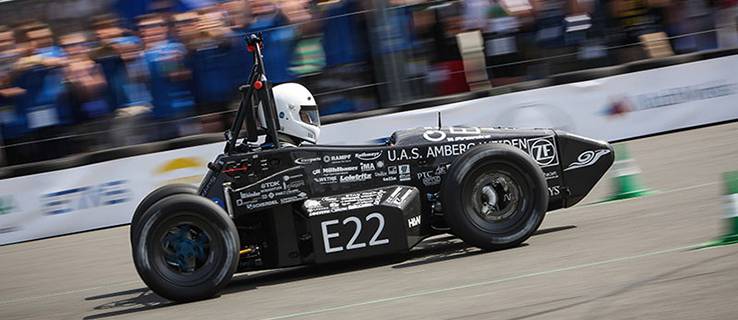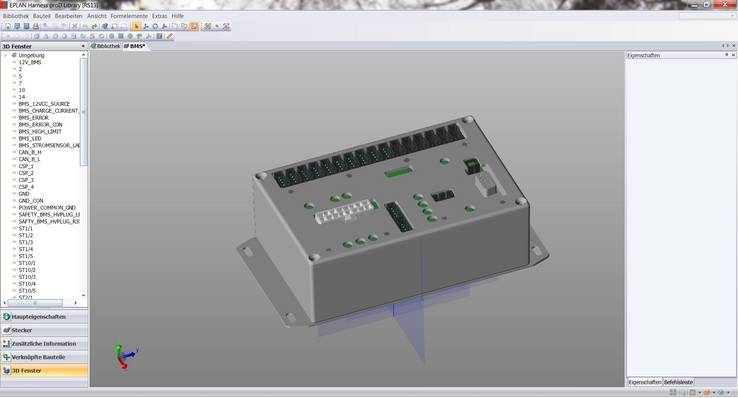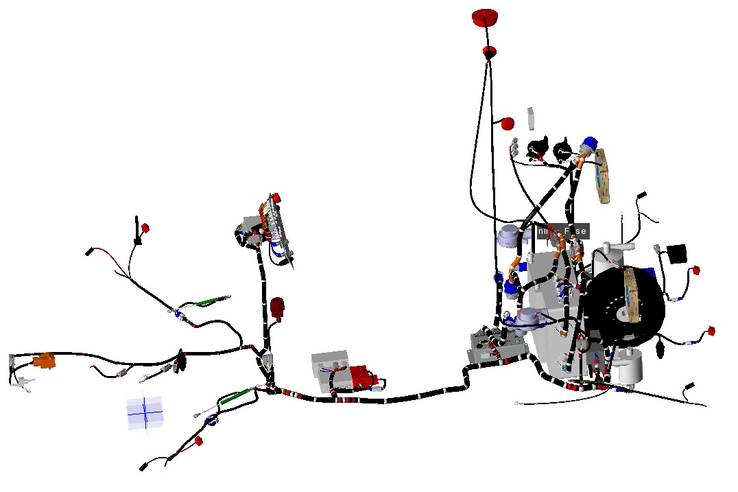EPLAN Harness proD for harness development in racecar construction
The Running Snail Racing Team from the Amberg-Weiden University has taken the challenge upon itself this year. The new harness tool EPLAN Harness proD was on board with them.
The Formula Student fascinates students who are studying a wide range of different courses in Germany - and it has been doing so ever since the start of the millennium. Since 2010, even electrically-powered vehicles have been eligible to enter the competition. The Running Snail Racing Team from the Amberg-Weiden University has taken the challenge upon itself this year. The new harness tool EPLAN Harness proD was on board with them. DThe Formula Student is a fascinating opportunity to collect work experience whilst still studying – by taking part in a motorsport project. The goal is to put together a racecar within one semester. Team Captain Stefan Dotzler said: "All the faculties from the Amberg-Weiden University are represented in our Running Snail Racing Team - from Engineering and Electrical Engineering right up to Marketing and Media Technology." Around 80 team members are investing a significant amount of their study time into this project. The Running Snail Racing Team has a number of successes under its belt. Even the first vehicle was so successful that the team received the "Best Newcomer Award". In 2010, they won the Formula Student Event in Hungary. Project Manager PR/Orga Konrad Bittner said: "We are a small university with just 3000 students and this is a massive accomplishment for a university of our size. We are competing against teams from much larger universities who have considerably more support, both in terms of finances and personnel." In the current season, the Running Snail Team concentrated for the first time on the electrically-powered version of Formula Student, the FSE (Formula Student Electric). Bittner explained: "This fits in very well with us, because our Faculty of Electrical Engineering and Information Technology places great emphasis on renewable energies. An electric drive naturally reflects the current trends of the automobile industry. Furthermore, we are working much more closely with the Faculty of Electrical Engineering and Information Technology than before. We want to show that electrical drive doesn't just represent a sacrifice; rather that it is fun and that it fits in with motorsport." Thomas Simson, harness module manager, explains the particular requirements of electrical drive: "There are 212 metres of cable in the new FSE vehicle, which is double the cable that was in last year's vehicle with a combustion engine. Around 400 single wires have been installed, which is three times that of last year's harness." Alongside the pure drive, the electrical equipment comprises a battery, an inverter and an engine as well as further areas and power units. The battery management is controlled by a microprocessor and it is designed to get the maximum driving power from the batteries; the driver can check the vehicle status by looking at the dashboard. The batteries and the engine are cooled and a variety of sensors collect data; this data ranges from brake pressure and temperature to range of the spring right up to the battery status. The regulations also require the installation of certain other things such as an emergency shutdown system and a signal horn to warn people standing in the vicinity of the vehicle when it is about to start. Simson collected the connections of all these components in EPLAN Harness proD, a software that EPLAN has been providing since the summer of 2012. In February, Running Snail received a licence as well as a 1-day training session to introduce the team members to the software. Simson recounts: "EPLAN Harness proD is largely self-explanatory and it was very easy to begin using it. We began using it straight after the 1-day training session and we then only had a few questions relating to the special functions of EPLAN." The connectors required are defined first in the Harness proD library. This deals with more than just the connector geometry, as the pin assignment and name of the individual wires are defined. The software then recognises which pins in which connectors are connected to one another and the wire harness builds itself practically on its own. Simson explained: "We developed the circuit diagram in Eagle. However, the time pressure meant that we could not use the import function of Harness proD. For direct import to take place, the designations of the connectors and the wires must be identical in the libraries of both programs. As the circuit diagram was already finished when we received the EPLAN Harness proD, we performed the transfer manually this year. We want to use the import interface in the next vehicle." The students took the 3D geometry of the vehicle and the position and orientation of the connectors from the 3D CAD system Creo 2.0 with which the racing vehicle was built. EPLAN Harness proD offers interfaces for the most important CAD systems and also for neutral formats such as IGES and STEP. In the software, the single wires can be collected together in a harness and the wire harness can be installed three-dimensionally. When doing so, the software takes note of the bend radius of the wire harness; the more cable it comprises of and the wider the cable is, the larger the bend radius will be. For example, a bend may turn red when the cable is being collected - this indicates that the minimum bend radius has been undershot while a cable is being inserted. By using the mouse, Simson can adapt the layout of the wire harness to ensure that the bend radius is adhered to. The last step consists of automatically creating a nail board drawing. This drawing is actually positioned on a large board and the course of the wire harness is shown using nails. This means that the individual wires can be placed onto the board and that the wire harness can be completed. Running Snail has had good experiences with this, as Simson explains: "The lengths of the cables have always been correct in the three-dimensional wire harness; the function installed in Eagle did not always produce this result. We were able to fit the wire harness into the vehicle straight away and we didn't forget a single cable when doing so." On top of that EPLAN Harness proD supplies valuable information that is needed when constructing the vehicle as the touch of a button. This includes such information as, for example, how much cable is needed in which colours and which diameters are required. Thomas Simson summarises it as follows: "It took us a month to go from nothing to a complete harness. This used to take much longer, although the wiring was much smaller. What's more, the cable lengths were exactly the right length, there was no need to add an extra bit for safety to the cable length. EPLAN Harness proD has brought us significant, measurable advantages. The system manufacturer provided excellent support and we were able to clear up any questions quickly on the telephone. The simple operation allowed us to work productively with the software, even alongside our studies."
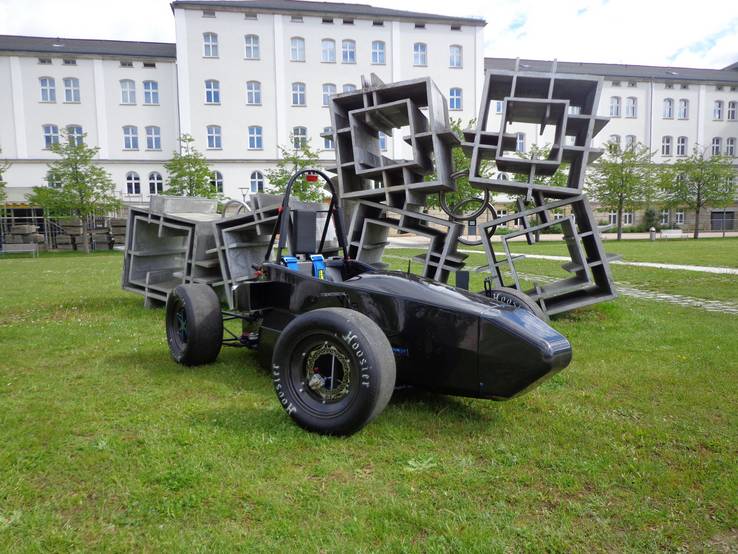
The Running Snail Racing Team from the Amberg-Weiden University fancies its chances with its electric racer.
Picture: Konrad Bittner, Amberg-Weiden university
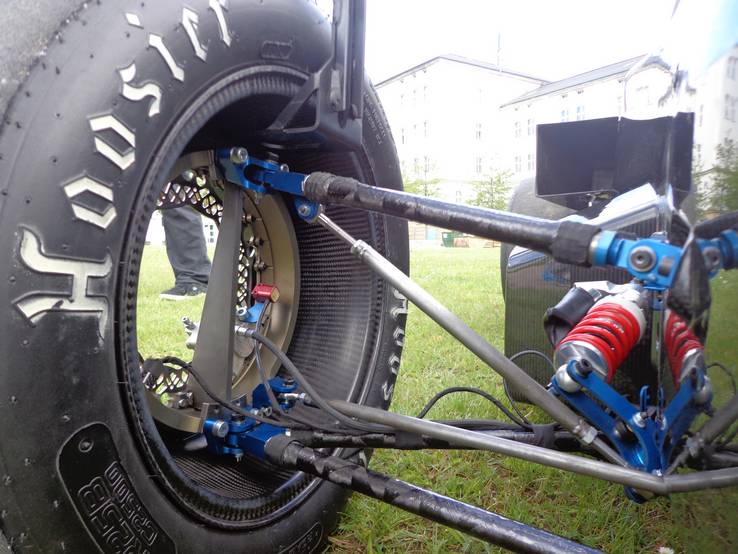
The special trademark of the Running Snail vehicle is the hollow front wheel rim that runs on a bearing ring.
Picture: Konrad Bittner, Amberg-Weiden university
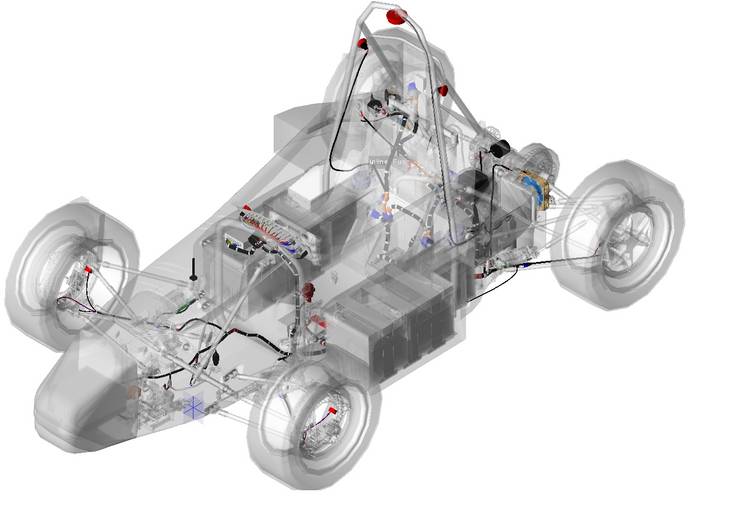
The harness of the racecar continues into the front axle, where sensors measure the brake temperature.
Picture: Konrad Bittner, Amberg-Weiden university


